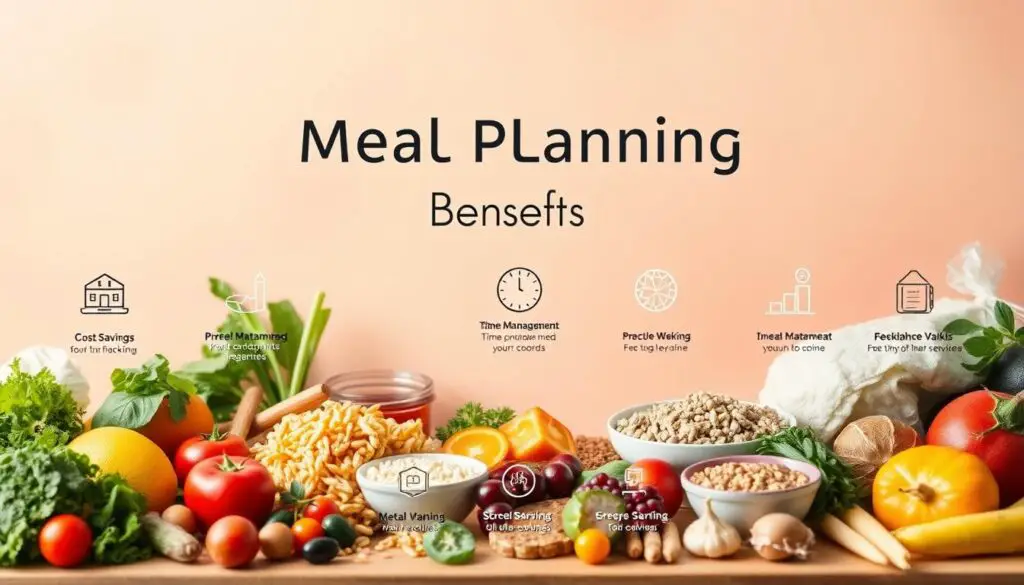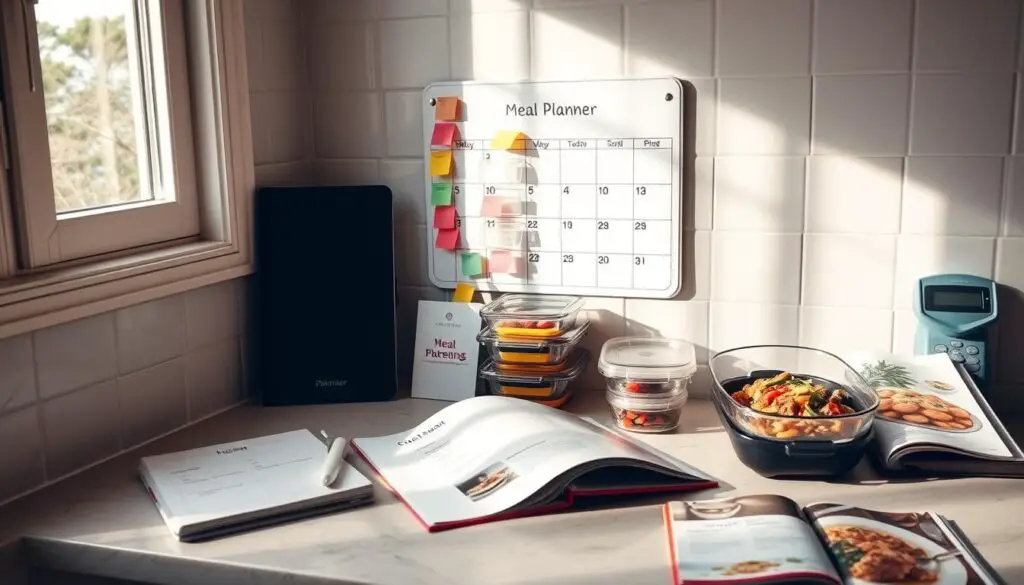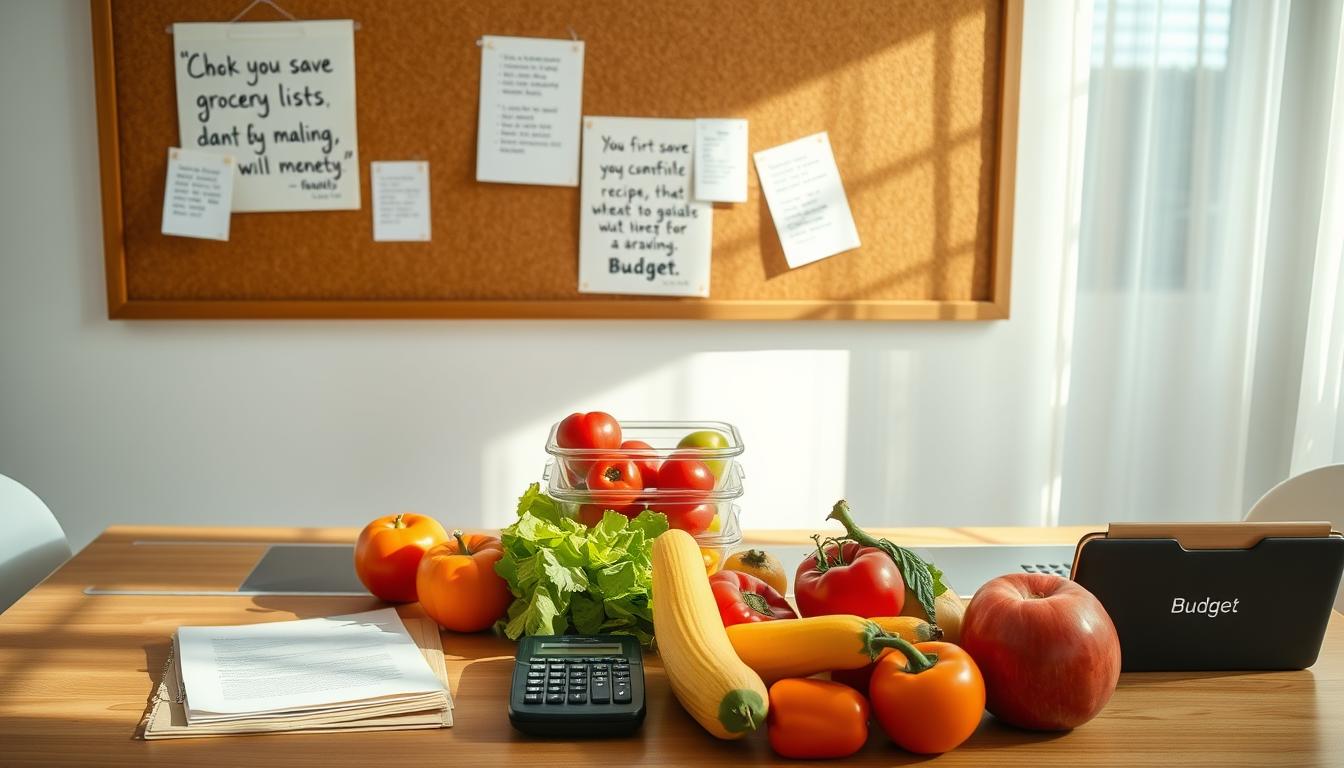Ever stared into an empty fridge, wondering how to buy groceries without overspending? You’re not alone. For many, food costs are one of the biggest monthly expenses. That’s where meal planning to save money comes in. It’s not just a trend it’s a smart strategy for anyone who wants to eat well, cut down on food waste, and stick to a budget.
Frugal cooking begins with a simple plan: making meals on purpose. By controlling your food budget, you can cut down on waste and make tasty, affordable meals. These meals will feed your body and wallet.
Budget meals don’t mean you have to give up on taste or health. They’re about planning, smart shopping, and making every dollar work. Meal planning can change how you see food and money, whether you’re alone or have a family.
Key Takeaways
- Meal planning is a proven method to reduce food expenses
- Strategic grocery shopping can save significant money
- Frugal cooking doesn’t mean compromising on flavor
- Consistent meal preparation leads to financial stability
- Anyone can learn to create budget-friendly meal plans
Understanding the Benefits of Meal Planning
Meal planning is more than just cooking. It’s a way to manage your kitchen, budget, and time. By using cost-effective meal plans, you can change how you cook and save a lot of money.

Using affordable meal prep techniques has many benefits. These benefits help your wallet and make cooking more efficient. Let’s look at why meal planning is key for those who want to save money.
Reducing Food Waste
Food waste can cost a lot. Saving money with recipes and meal planning can greatly reduce waste. By planning meals ahead, you:
- Buy only what you need
- Use up perishables before they go bad
- Make meals that use similar ingredients
Minimizing Grocery Store Visits
Going to the grocery store too often can lead to spending more than you should. Meal planning helps you:
- Go shopping less often
- Stick to a shopping list
- Avoid spending on impulse buys
Cutting Down on Takeout Expenses
Takeout and eating out can quickly add up. With good meal planning, you can cut down on these costs:
| Expense Category | Average Monthly Cost | Potential Savings |
|---|---|---|
| Takeout Meals | $250 | Up to $150 |
| Grocery Meal Prep | $100 | Significant Reduction |
By using these strategies, you save money and control your diet better. Meal planning is an investment in your financial and personal well-being.
Getting Started with Basic Meal Planning Tools

Starting your journey to cheap and healthy meals is easier with the right tools. Many resources make money-smart grocery shopping simple. They help you plan meals without spending a lot.
Digital apps have changed meal planning for those on a budget. Apps like Mealime and Paprika offer free versions. They help you:
- Create personalized recipe collections
- Generate automated grocery lists
- Track ingredient costs
- Plan meals based on your budget
If you prefer old-school methods, printable templates are great. Nutrition websites and the USDA offer free meal planning worksheets. These templates have sections for:
- Weekly meal schedule
- Grocery list
- Budget tracking
- Nutrition information
You don’t need fancy software to plan meals on a budget. A notebook or smartphone app works well. The important thing is to be consistent and find a system that suits you.
When choosing a meal planning tool, think about its ease of use and device compatibility. Also, see if it helps track grocery expenses. Start simple and improve as you get better at meal planning.
How Meal Planning to Save Money Actually Works
Changing how you plan meals can save you money. It’s not just about picking what to eat. It’s a way to make meals that are easy on your wallet.
Smart meal planning means using your grocery budget wisely. With the right strategies, you can cut down on food costs. This way, you can make tasty, affordable meals for your family.
Creating Shopping Lists That Work
A good shopping list is key to saving money. Here are some tips:
- Check what you already have at home before you shop
- Plan meals with what you already have
- Stay true to your list to avoid buying things you don’t need
- Use apps to compare prices and find deals
Strategic Grocery Shopping
Shop like a pro with these tips for saving money:
| Strategy | Potential Savings |
|---|---|
| Buy generic brands | Up to 30% off name brands |
| Purchase seasonal produce | 25-50% cheaper |
| Compare unit prices | 10-20% additional savings |
Utilizing Sales and Discounts
Save more by strategic discount hunting. Look for weekly ads, digital coupons, and loyalty programs. These can cut down your grocery costs a lot.
- Sign up for store loyalty cards
- Download grocery store apps for exclusive discounts
- Plan meals around current sales
- Stock up on non-perishable items during deep discounts
By using these strategies, you can change how you plan meals. This way, you can feed your family well without breaking the bank.
Creating Your First Weekly Meal Plan
Starting your first weekly meal plan can seem daunting. But, it’s a big step towards saving money on meals. Begin by checking what you already have in your kitchen. This helps avoid buying things you don’t need and makes meal planning more budget-friendly.
When planning your meals, keep it simple. Pick a few breakfast and lunch ideas that you can switch up during the week. This makes meal planning easier and less stressful.
- Check your pantry and refrigerator before shopping
- Select versatile ingredients that work in multiple dishes
- Plan meals around weekly grocery store sales
- Incorporate leftovers into your next day’s meals
Your meal plan should be flexible. Aim for progress, not perfection. Realistic meal planning means being okay with quick changes. Have some easy meal ideas ready for when things don’t go as planned.
Think about using a spreadsheet or meal planning app to keep track of your meals. It helps you stay organized and makes planning meals for the future easier. The goal is to save time and money while still eating well.
Smart Inventory Management for Your Kitchen
Effective kitchen inventory management is key to frugal cooking and saving money. Your kitchen can be a place where you reduce waste and lower grocery bills. This happens when you use smart ways to organize.
Tracking your food helps you plan meals and shop better. Knowing what you have prevents extra trips to the store and cuts down on waste.
Pantry Organization Tips
- Use clear storage containers to see ingredients easily
- Label containers with purchase or open dates
- Arrange items by expiration date
- Keep a running inventory list
Freezer Storage Solutions
Freezing food is a great way to save money and extend shelf life. Learn how to package and store food right to keep it fresh and prevent freezer burn.
| Food Type | Recommended Freezer Storage Time |
|---|---|
| Cooked Meats | 2-6 months |
| Vegetables | 8-12 months |
| Prepared Meals | 3-4 months |
Refrigerator Management
Organizing your fridge well can make food last longer. Here are some tips to make your fridge more efficient:
- Store raw meats on bottom shelves
- Keep dairy products in the coldest areas
- Use designated produce drawers
- Regularly check and rotate perishable items
By using these inventory management tips, you’ll make your kitchen more efficient for cooking on a budget.
Budget-Friendly Meal Planning Strategies
Creating cost-effective meal plans doesn’t mean you have to give up taste or nutrition. With the right strategies, you can turn your kitchen into a place where you save money. And still, enjoy delicious and exciting meals.
Using plant-based proteins is a smart move for saving money. Beans, lentils, and chickpeas are packed with nutrients and are much cheaper than meat. They can be the main attraction in many dishes, helping you stretch your budget.
- Incorporate meat-free days each week
- Buy seasonal produce to reduce costs
- Purchase ingredients that work across multiple recipes
- Leverage bulk buying for staple ingredients
Strategic cooking can make your meal plans much cheaper. Batch cooking lets you make several meals at once. This saves time and helps avoid expensive takeout.
Here are some affordable protein options for your meal prep:
| Protein Source | Average Cost per Serving | Nutritional Value |
|---|---|---|
| Dried Beans | $0.25 | High protein, fiber |
| Eggs | $0.30 | Complete protein |
| Canned Tuna | $0.50 | Omega-3 fatty acids |
Being creative with ingredients and cooking can lead to affordable and fulfilling meals. Remember, smart shopping and strategic cooking are your best tools for budget-friendly nutrition.
Time-Saving Batch Cooking Methods
Batch cooking is a game-changer for making cheap and healthy meals. It also helps you save money on groceries. By spending a few hours cooking, you can change your weekly meals and save time and money.
Batch cooking lets you cook many meals at once. This reduces daily cooking stress and stops you from spending on takeout. It makes your kitchen work better and keeps your meals affordable.
Prep Day Organization
For efficient prep days, plan ahead. Start by:
- Choosing recipes that use the same ingredients
- Gathering all needed cooking tools and containers
- Preparing ingredients in bulk
- Using different cooking methods at the same time
Storage and Portioning
Good storage keeps your meals fresh. Get quality, stackable containers for freezer to microwave use. Portion your meals into individual servings for easy reheating and eating all week.
Reheating Guidelines
Reheating foods right keeps their taste and texture. Here are some tips:
- Use containers safe for the microwave
- Add a bit of water for moisture
- Stir halfway through reheating
- Make sure it’s hot enough, at least 165°F
Using these batch cooking tips, you’ll make a lasting change. You’ll enjoy cheap and healthy meals and save money on groceries.
Building a Rotating Meal Schedule
Creating a rotating meal schedule changes how you plan meals. It makes planning easier and keeps meals exciting. By picking a few meals to repeat, you save time and money.
Your meal schedule should have meals that can change easily. Try theme nights to make things more fun:
- Taco Tuesday: Try chicken, beef, fish, and vegetarian options
- Pasta Wednesday: Switch up sauces and proteins
- Soup or Stew Thursday: Use what’s in season
Choose recipes that can be changed to fit your family’s tastes. Look for meals that:
- Use the same basic ingredients
- Can be spiced up differently
- Work for everyone’s diet
Seasonal changes are key for a great meal rotation. Grilled foods are perfect for summer, while soups are better in winter. Keep track of your family’s favorites and adjust your rotation to please everyone and reduce waste.
Shopping Smart: From List to Kitchen
Meal planning to save money begins with smart shopping. This can cut down your grocery bills a lot. By using clever shopping tips, you can make your meals affordable.
Good budget meals need more than just a recipe. They also need smart buying choices. These choices help save money without losing nutritional value.
Seasonal Shopping Tips
Shopping by season can really help your budget. Produce prices change with the seasons:
- Summer: Stock up on berries, tomatoes, and stone fruits
- Fall: Purchase squash, apples, and root vegetables
- Winter: Focus on citrus fruits and hearty greens
- Spring: Enjoy asparagus, peas, and leafy greens
Bulk Buying Strategies
Buying in bulk can save you a lot of money. Focus on non-perishable and freezer-friendly items you use often in your meals.
- Rice and grains
- Dried beans
- Frozen vegetables
- Bulk meat when on sale
Store Brand Savings
Store brands are often just as good as name brands but cheaper. Check the ingredients and prices to save more without sacrificing quality.
When you mix these shopping tips, your meal planning to save money strategy gets even stronger. This makes cooking on a budget more effective.
Making Your Meal Plan Sustainable Long-Term
Turning frugal cooking into a lasting habit is more than just wanting to. You need consistent strategies to stay motivated and keep saving money. This is key to your meal planning journey.
Creating a sustainable meal planning routine involves several key approaches:
- Track your financial savings from meal planning
- Celebrate small victories in your budget
- Build flexibility into your weekly menu
- Develop backup meal options
Getting your family involved can make meal planning fun. Let everyone help out, like picking recipes or shopping for ingredients. This way, everyone feels part of the effort and is more likely to stick with frugal cooking.
| Strategy | Benefits |
|---|---|
| Flexible Meal Planning | Reduces stress and prevents burnout |
| Seasonal Adaptation | Keeps meals interesting and cost-effective |
| Backup Meal Options | Prevents unexpected takeout expenses |
Make freezer-friendly meals for emergencies. When life gets in the way and you can’t stick to your plan, having something ready in the freezer saves you from expensive takeout. It keeps your money-saving strategy on track.
Remember, sustainable meal planning is about making progress, not being perfect. Stay flexible, stay positive, and watch your frugal cooking skills grow!
Conclusion
Starting cost-effective meal plans is more than saving money. It’s a big change in how you manage your kitchen and life. By following the tips in this guide, you can cut down on food costs. You’ll also enjoy healthy, homemade meals.
Learning to prep meals on a budget takes time. Begin by planning a few meals a week and grow from there. It might be tough at first, but the benefits will show soon. The main thing is to keep going and learn from your mistakes.
Meal planning does more than save money. It also improves your diet, reduces stress, and gives you control over what you eat. Every step towards affordable meal plans makes your kitchen more organized and budget-friendly.
Your journey to better eating starts today. Be open to new ideas, try different methods, and see how meal planning changes your life. Every meal you plan is a step towards better finances and cooking skills.


1 thought on “Meal Planning to Save Money: A Beginner’s Guide”
Comments are closed.